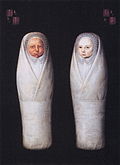Difference between revisions of "Twin placentas"
Jump to navigation
Jump to search
m (→Gross) |
m (→Sign out) |
||
| Line 60: | Line 60: | ||
===Sign out=== | ===Sign out=== | ||
====Normal==== | |||
<pre> | <pre> | ||
TWIN PLACENTA, UMBILICAL CORDS AND FETAL MEMBRANES, BIRTH: | TWIN PLACENTA, UMBILICAL CORDS AND FETAL MEMBRANES, BIRTH: | ||
| Line 72: | Line 73: | ||
-- FETAL MEMBRANES WITHIN NORMAL LIMITS. | -- FETAL MEMBRANES WITHIN NORMAL LIMITS. | ||
-- PLACENTAL DISC WITH THIRD TRIMESTER VILLI WITHIN NORMAL LIMITS. | -- PLACENTAL DISC WITH THIRD TRIMESTER VILLI WITHIN NORMAL LIMITS. | ||
</pre> | |||
====Early delivery==== | |||
<pre> | |||
TWIN PLACENTA, UMBILICAL CORDS AND FETAL MEMBRANES, BIRTH: | |||
- FETAL MEMBRANES AT T-ZONE: | |||
-- CHORION PRESENT (DIAMNIOTIC-DICHORIONIC GESTATION). | |||
- TWIN A: | |||
-- THREE VESSEL UMBILICAL CORD WITHIN NORMAL LIMITS. | |||
-- FETAL MEMBRANES WITHIN NORMAL LIMITS. | |||
-- PLACENTAL DISC WITH FOCALLY MILDLY LARGE THIRD TRIMESTER VILLI AND | |||
ZONAL CONGESTION. | |||
- TWIN B: | |||
-- THREE VESSEL UMBILICAL CORD WITHIN NORMAL LIMITS. | |||
-- FETAL MEMBRANES WITHIN NORMAL LIMITS. | |||
-- PLACENTAL DISC WITH FOCALLY MILDLY LARGE THIRD TRIMESTER VILLI. | |||
</pre> | </pre> | ||
Revision as of 10:41, 13 September 2013
Twin placentas often come to the pathologist... even if they are normal. In these specimens, usually, the chorion is the key; the pathologist may be able to sort-out whether the twins are monozygotic (identical) or dizygotic (fraternal).
Monozygotic versus dizygotic twins
Monoamniotic-monochorionic gestation
- Abbreviated MoMo.
General
- Split at approximately 7th day.
- Always monozygotic twins.
Gross
- No membrane between the fetuses - apparently clinically.
Diamniotic-monochorionic gestation
- Abbreviated DiMo.
General
- Always monozygotic.
- Highest risk of TTTS (twin-to-twin transfusion syndrome).
Gross
- Thin membrane at T-zone.
Microscopic
Features:[1]
- One chorion (no decidua) in the T-zone.
Images
Sign out
TWIN PLACENTA, UMBILICAL CORDS AND FETAL MEMBRANES, BIRTH: - FETAL MEMBRANES AT T-ZONE: -- CHORION ABSENT (DIAMNIOTIC-MONOCHORIONIC GESTATION). - TWIN A: -- THREE VESSEL UMBILICAL CORD WITHIN NORMAL LIMITS. -- FETAL MEMBRANES WITHIN NORMAL LIMITS. -- PLACENTAL DISC WITH THIRD TRIMESTER VILLI WITHIN NORMAL LIMITS. - TWIN B: -- THREE VESSEL UMBILICAL CORD WITHIN NORMAL LIMITS. -- FETAL MEMBRANES WITHIN NORMAL LIMITS. -- PLACENTAL DISC WITH THIRD TRIMESTER VILLI WITHIN NORMAL LIMITS.
Diamniotic-dichorionic gestation
- Abbreviated DiDi.
General
- Most dizygotic (70%), may be monozygotic (30%).
- If monozygotic -- split before 3 days.
Gross
- Thick membrane at T-zone.
Microscopic
Features:
- Decidua interposed between two chorions.
Images
Sign out
Normal
TWIN PLACENTA, UMBILICAL CORDS AND FETAL MEMBRANES, BIRTH: - FETAL MEMBRANES AT T-ZONE: -- CHORION PRESENT (DIAMNIOTIC-DICHORIONIC GESTATION). - TWIN A: -- THREE VESSEL UMBILICAL CORD WITHIN NORMAL LIMITS. -- FETAL MEMBRANES WITHIN NORMAL LIMITS. -- PLACENTAL DISC WITH THIRD TRIMESTER VILLI WITHIN NORMAL LIMITS. - TWIN B: -- THREE VESSEL UMBILICAL CORD WITHIN NORMAL LIMITS. -- FETAL MEMBRANES WITHIN NORMAL LIMITS. -- PLACENTAL DISC WITH THIRD TRIMESTER VILLI WITHIN NORMAL LIMITS.
Early delivery
TWIN PLACENTA, UMBILICAL CORDS AND FETAL MEMBRANES, BIRTH: - FETAL MEMBRANES AT T-ZONE: -- CHORION PRESENT (DIAMNIOTIC-DICHORIONIC GESTATION). - TWIN A: -- THREE VESSEL UMBILICAL CORD WITHIN NORMAL LIMITS. -- FETAL MEMBRANES WITHIN NORMAL LIMITS. -- PLACENTAL DISC WITH FOCALLY MILDLY LARGE THIRD TRIMESTER VILLI AND ZONAL CONGESTION. - TWIN B: -- THREE VESSEL UMBILICAL CORD WITHIN NORMAL LIMITS. -- FETAL MEMBRANES WITHIN NORMAL LIMITS. -- PLACENTAL DISC WITH FOCALLY MILDLY LARGE THIRD TRIMESTER VILLI.
Pathology seen only in twin pregnancies
Twin-to-twin transfusion syndrome
General
- Abbreviated as TTTS.
Definition:
- Monozygotic twins that share a placental disc, have vessels which cross-over between the twins that lead to a blood imbalance between the two twins.
- Only seen in monozygotic twins.
- Vascular connection may be vein-to-vein, artery-to-vein, artery-to-artery (uncommon).[2]
Prevalence:
- Seen in ~15% of monozygotic twins.[2]
Clinical:
- Donor:
- Twin: hypovolemic, oliguric, oligohydramnic, +/- anemia, +/-hypoglycemia, +/- small pale organs.
- Placental disc: large, pale.
- Recipient:
- Twin: hypervolemia, polyuria, polyhydramnios, +/- hydrops fetalis, +/- CHF, hemolytic janundice, +/- large congested organs.
- Placental disc: small, firm, congested.
Gross
- Large vessels that connect the two umbilical cords.
Image:
Microscopic
Features:[3]
- Artery-to-vein anatomosis - where artery and vein are associated with different umbilical cords.
- Donor twin side of placenta:
- Edematous villi.
- Increased nucleated RBCs.
- Recipient twin side of placenta:
- Congested.
See also
References
- ↑ Sternberg, Stephen S. (1997). Histology for Pathologists (2nd ed.). Lippincott Williams & Wilkins. pp. 979. ISBN 978-0397517183.
- ↑ Jump up to: 2.0 2.1 Humphrey, Peter A; Dehner, Louis P; Pfeifer, John D (2008). The Washington Manual of Surgical Pathology (1st ed.). Lippincott Williams & Wilkins. pp. 469. ISBN 978-0781765275.
- ↑ Humphrey, Peter A; Dehner, Louis P; Pfeifer, John D (2008). The Washington Manual of Surgical Pathology (1st ed.). Lippincott Williams & Wilkins. pp. 469-70. ISBN 978-0781765275.
